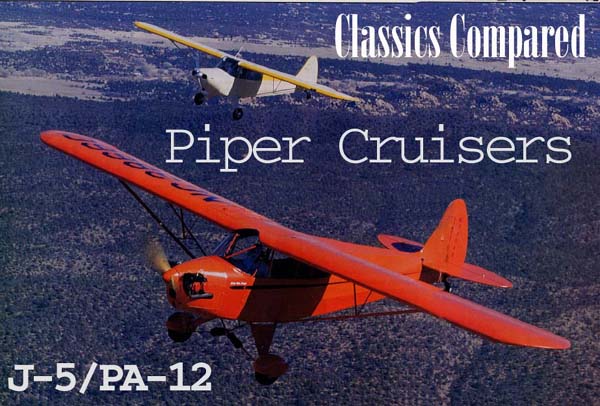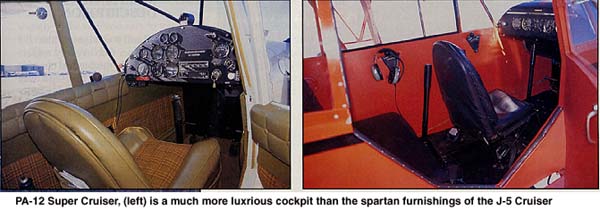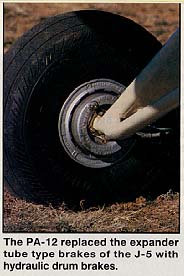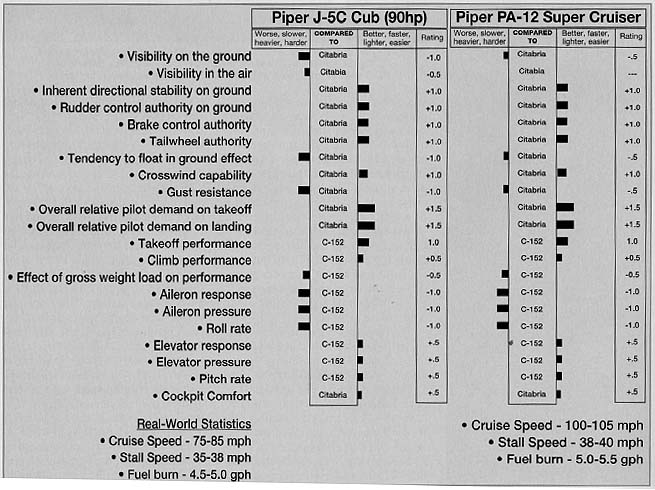

It could easily be said that in it's pre-Cherokee incarnation, Piper Aircraft designed only one airplane, the J-3 Cub (which actually pre-dated that company). They then re-designed, re-assembled, re-engineered and re-used the airplane's major components in a bewildering number of combinations and permutations. Evolution was the name of the Piper game. Use as much existing tooling, parts and investment as possible, when designing a new airplane.
The J-3's first evolutionary step was the J-4 Cub Coupe. Same airplane, different seating. The two occupants sat side by side, rather than in tandem.
The second step up the passenger-carrying ladder was the J-5 Cruiser. This was Piper's first move into multi-passenger aircraft. The J-5 was also the first indication Piper was looking past the training market at bigger goals.
Let's not kid ourselves: The J-5 IS a J-3. It's a Cub with fat hips where the rear seat was widened out. The wings and tail are identical. However the evolutionary changes in the fuselage set a re-design effort in motion that was to give birth to an entire string of multi-passenger airplanes.
An important change in the fuselage and general layout was moving the pilot up front and moving the front seat away from the pedals. Any who have flown a J-3 in the front remember that folded-like-a-pocket-knife seating position and the chest-high control stick. The Piper engineering crew made an effort to civilize the front seat by giving it more leg room. In addition, when widening the back seat and tapering the fuselage to the firewall, they couldn't help but give the front seat lots of shoulder room. In fact, the front seat clearance may be the widest of any aircraft of its type, before or since.
 The
original J-5A came out in January of 1940 being pulled along by
a 75 hp Continental. A year later it was replaced by the J-5B
which used the 75 hp Lycoming 0-145, an engine which has never
had a reputation for lots of power.
The
original J-5A came out in January of 1940 being pulled along by
a 75 hp Continental. A year later it was replaced by the J-5B
which used the 75 hp Lycoming 0-145, an engine which has never
had a reputation for lots of power. In 1942 Piper made a major jump forward when it announced the J-5C which was powered by the 100 hp 0-235 Lycoming. Yes, this is the same 0-235 Lycoming (with very minor changes) still being used in C-152s and, yes, that makes the basic engine 55 years old! The only difference is that in the J-5C the engine was carrying three people not two, as in the C-152. Sorry, just a little editorializing.
The Charlie model included some major structural changes. Among other things the windshield was now one piece and the wood spars gave away to aluminum. Early J-5C's will be found with wood spars because they didn't complete the change-over until using up all the wood then in inventory. The landing gear was redesigned to bring the bungees up inside the airplane and the engine was completely cowled for the first time.
The cowling and landing gear mods amounted to a huge drag reduction which, when coupled with the equally dramatic increase in power made the airplane live up to its name. At 95-100 mph it truly was a Cruiser. Plus it offered amenities like a starter and nav lights. An 18 gallon wing tank was standard in all Cruisers, but another seven or 18 gallons could be put in the other wing. With the J-5C Cub Cruiser, Piper had stepped into the serious cross country market. Unfortunately, the war shut down Piper's civilian aircraft production after cranking-out only 35 J-5Cs.
The new design didn't go to waste, however. The Navy liked what they saw in the airplane and, with several of their own mods, including a top-opening rear fuselage for a litter, ordered the aircraft as the HE-1. Something over 100 were produced.
After the war, the J-5C was re-certified to 1,750 pounds gross weight (Normal Category) and the 1020 mild steel in the fuselage tubing replaced with chrome-moly. The new airplane was the PA-12 Super Cruiser. It was produced for two years, 1946-'47 and over 3,700 were built. Approximately 1,400 J-5s were built.
It appears the Piper marketing department had as much to do with the design of the PA-12 as engineering did. In most respects, it's structure was identical to the J-5C but marketing's contribution was in taking a noticeable step away from the stark interior of the traditional Cub to much more luxurious appointments. The 1946 market place was fiercely competitive and they needed to change their image to survive. Accordingly, many of the Cub's old control layouts, some of which were the result of its trainer role, were changed. For instance the carb heat was now on the panel, as was the mixture for the 0-235. The panel itself was arranged to make room for a radio ($65 installed!). The interior was tastfully appointed and an effort made to bring it up to automotive standards of style and comfort.
It should be pointed out, however, that the back seat of either Cruiser isn't really two people wide. It's more like 1 3/4 people wide since they have to twist and let their shoulders slightly over lap. With only one person in the seat, the extra room is overkill.
 Mechanical Discription
Mechanical Discription
As originally designed, the J-5 Cruiser is a Piper Cub in every respect and so needs little mechanical discription. The steel tube fuselage was widened and that was the only discernable difference. In fact, most major components, wings, tail surfaces, landing gear vees, are interchangeable.
One minor control change is that the carb heat was moved from its awkward location by the pilot's right foot to make it more convenient by his left hip. The aluminum cup holding the carb heat and fuel cut off is unique to the J-5, even though the Cub has something similar.
The original brakes were the traditional expander-tube type which are terribly expensive to rebuild today because of the cost of the expander tubes and the individual brake blocks. Many J-5s are seen with either the hydraulaic drum brakes of the PA-12 or Cleveland/McCauly disk brakes.
The brake pedals on both models are of the heel variety, with those on the PA-12 moved slightly out board to make them more readily available. This also puts them slightly in the way and easy to touch inadvertendly on the first few flights.
The J-5C and PA-12 landing gears moved the bungees up inside the airplane, so the bungee struts and the structure at the front end of the fuselage is noticeably different.
Other than the usual fuselage rust concerns, the Cruiser series also have the Piper strut AD's to be complied with. The wing ribs are aluminum as are the later spars.
Flight Characteristics
Not wanting to rely on memory, we traveled to Tailwheels and More in Prescott, Arizona which use a J-5A in their instruction progam and have a prestine PA-12 on line for rent. There we evaluated both airplanes with Allen Steffey, owner/operator of Tailwheels, acting as instructor pilot.
Steffy's J-5A is redone in the colors it carried in 1941 when delivered to Muncie Aviation, where it served in a CPT school. In speaking with old-time Muncie instructors, Allen learned they used the J-5's as night trainers with motorcycle batteries providing the lighting power.
The airplane was wrecked at least three times before being purchased by a doctor in Bisbee, Arizona who re-engined it with a C-90. Each year, the doctor used the airplane to deliver medical supplies to Panama, which, according to the logs, took 70 hrs each way! In the late 1980's the doctor was having the airplane re-built when he passed away. Steffy bought the airplane as a nearly completed project and incorporated it into his school, which also uses Champs, C-140's and a Stinson.
The airplane's bad luck wasn't left behind when it moved up to Prescott. After Allen took it to Oshkosh '96, it wound up on its back when, it is surmised, a passenger surprised a renter pilot by inadvertently locking the brakes. Steffey completely rebuilt the airplane, correcting many of the non-original features it had picked up over the years. He did not, however, rebuild the expander tube brakes because of the expense involved, and retained the Clevelands.
In climbing into the cockpit, I was first struck by it's size, when compared to a Cub. Spacious would be the best adjective to apply. The rudders were still just a little closer than I'd like, but we have to remember this generation is taller than that for which the airplane was designed. Even better than the room, was the over-the-nose visibility. Straight ahead visibility was only slightly impaired.
"Mags hot! Brakes!" One flip of the prop and we were on our way. The heel brakes were a fair amount inboard of the rudders which was of no consiquence because they were only needed for tight maneuvering during taxi. Also, even though we had a 20-25 knot wind battering us during taxi, the tendency to weathervane was easily controlled with rudder only. A J-5 is at least 100 pounds heavier than a J-3 and its ability to ride out the wind is one place it helps.
The wind was varying between 30°-60° off our nose on takeoff and I expected an "interesting" flight. I wasn't disappointed but I was surprised at how well the airplane handled it. The takeoff run had to be partially on one wheel to keep it straight but the controls were absolutely up to the task. Even though the airplane had 90 hp, we were at 5,000 ft MSL (density altitude around 6,500 ft.), so the power was probably the equivalent of the original 75 hp Continental. This gave the wind plenty of time to work us over during the takeoff roll. At no time did it feel as if the wind was about to get the upper hand so long as I used a firm touch. At lower altitudes, with that engine, takeoffs happen instantaneously, with a 150 foot take-off roll being typical.
 Once off the ground,
it became clear the J-5 may have the seats to carry three people,
but with only 75 hp it definitely wouldn't have the power. With
the Lycoming 0-145, it must be particularly anemic. At that altitude,
with the C-90 and only two people, we were getting something around
350-400 fpm and it was a relatively cool day. Allen's airplane
has a nice new Sensenich wood prop, which limits static power
to around 1950 rpm and about 2100 rpm on takeoff. A metal prop
would probably increase that at least 200 rpm and give a significant
performance increase. But nothing looks as nice as wood. Also,
the wood prop protects the engine against sloppy renter pilots.
Once off the ground,
it became clear the J-5 may have the seats to carry three people,
but with only 75 hp it definitely wouldn't have the power. With
the Lycoming 0-145, it must be particularly anemic. At that altitude,
with the C-90 and only two people, we were getting something around
350-400 fpm and it was a relatively cool day. Allen's airplane
has a nice new Sensenich wood prop, which limits static power
to around 1950 rpm and about 2100 rpm on takeoff. A metal prop
would probably increase that at least 200 rpm and give a significant
performance increase. But nothing looks as nice as wood. Also,
the wood prop protects the engine against sloppy renter pilots.
The controls on the J-5 are vintage Piper Cub, meaning a fair amount of system friction combined with reasonable pressures and responses.
Compared to a C-152, the pressures would seem high while the roll rates and response would seem low. Compared to a Citabria, however, only the system friction would be a factor, as the airplane handles at least on a par with the Citabria. Its performance in climb would compare favorably with a 115 hp Citabria (7ECA) similarly loaded.
The PA-12 we flew later was a gorgeous speciman restored over a ten year period by Floyd Newton of Phoenix, Arizona and now owned and operated by Tailwheels and More as part of their rental fleet. It was upholstered like a King Air and simply saying the airplane was well detailed is a gross understatement. The airplane is an easy 150-200 pounds heavier than the J-5 which is readily apparent in everything about it. Even its ride in turbulence was a little smoother.
System friction, which was very much a control factor in the J-5, was almost non-existent in the PA-12. We examined the J-5's control system looking for the difference, including examing the lpulleys, and could find nothing hanging up anywhere. We concluded the difference was simply in the cable tension. The manual calls for "slight" tension in the cables, which leaves a lot open to interpretation. Incidentally, the cables in all Cruisers are internal, rather than hanging out in the wind ala J-3.
Another noticeable difference was that the PA-12 seat was located three inches further away from the stick and the control pedals which made for a much more comfortable seating position.
We were climbing the J-5 at 45 knots and the PA-12 at 65 knots. Both gave about the same performance, even though the PA-12 had 108 hp.
In cruise, Allen's J-5 was nearly perfectly in rig and gave a solid 75 knot cruise while the PA-12 showed an honest 90-95 knots. This is where the cleaner cowl and internal bungees showed their advantages. Also, the PA-12's upholstery combined with its exhaust system to make the interior much quieter and more comfortable.
No matter how the airplanes were stalled, the stalls were non-events. With the stick against the stop and the nose gently bobbing, I tried driving the ball off centera with rudder to see the effect of yaw. The ball had to be way out before the airplane showed any willingness to fall off one way or the other.
With the tower reporting 20-25 knot winds at a steep angle to the runway, I was hesitant to three-point the airplanes, but in the interest of science was willing to try. I was openly surprised at how well they handled the wind. It was clearly a struggle to fight the tendency to balloon in the gusts and the bank angle was constantly changing to keep from drifting, but the airplane handled it beautifully.
The PA-12 had a softer feeling gear which was mostly noticeable during wheel landings. It was a little more forgiving and less likely to spring us back into the air. Both airplanes, however, handled far more wind than I would have thought possible. It, however, would not have been a great day for a student or low-time pilot to be out dicing around. Even though the airplane's would handle the wind, the pilot has to be very firm with them to keep them in line. Also, once on the ground, snails were racing past us, we were taxiing so gingerly to keep the wind from picking us up. In airplanes with such low wind loadings, the wind is a constant threat until the tie-down ropes are in place.
Incidentally, the hydraulic drum brakes on the PA-12 were more comfortable to use than the Clevelands on the J-5 because the Clevelands could easily be used too heavily.
It was easy to see why so many J-5's and especially PA-12's have migrated north to Canada and Alaska where they are usually re-engined with 150 hp. With the airplanes' low speed capabilities and the cabin room, all they need are more ponies to become ideal bush birds.
The Cruiser series of Pipers has only recently caught on, with the J-5 still lagging far behind the Cub in price. PA-12's have definitely begun to jump into the lime light but J-5's can still be found which are super deals and are easy rebuild projects. Just keep your eyes open. The word hasn't gotten out and you never know what you'll find. BD
